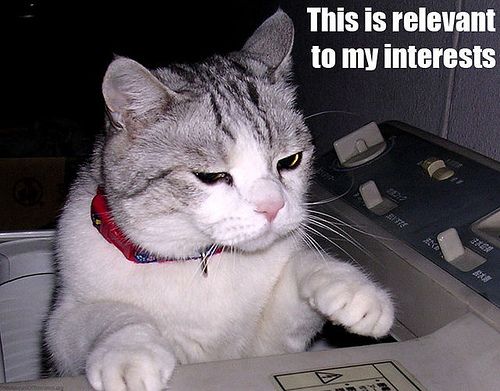What is SEO? The acronym stands for search engine optimization. But the definition of SEO is a more difficult question.
It’s not what it once was, that’s for sure. It is not just a niche edits service, but much more. The problem is, I see references to outdated definitions of SEO on a fairly regular basis.
If you have arrived here thinking SEO is a sham, snake oil and/or dead then a) you are grossly mistaken and b) let me disabuse you of that notion.
SEO Definition
Here’s my definition of SEO in 2012.
Search Engine Optimization is a multidisciplinary activity that seeks to generate productive organic traffic from search engines via technically sound and connected sites by matching query intent with relevance and value.
It’s a bit of a mouthful, I know. I’ve emphasized the areas that I feel are particularly important and deserve a more in-depth explanation.
Productive Traffic

The goal of SEO is not to increase traffic willy-nilly. You increase traffic by 30% but it makes no difference to the bottom line. Who cares!
Productive can mean different things to different companies. Productive may mean leads or subscribers or revenue or page views. Whatever it is, it’s important to define and track productive traffic rather than simply focusing on increasing traffic overall.
I might be able to generate more traffic by adding ‘Nude’ and ‘Free’ as keyword modifiers but is that really going to bring productive traffic to a site?
This goes (way) beyond brand versus non-brand traffic, which I find to be the most rudimentary of divisions. This is having a fundamental understanding of the traffic that makes a difference to that business.
That may mean moving away from high volume terms and generating less traffic overall. Don’t get saucer eyes when it comes to keyword volume. It’s about the right keywords, not the biggest keywords. (That’s what she said!)
Yet, even if you’re driving the right traffic there are other factors that contribute to a productive visit. If the focus is leads, you might realize that the call-to-action is weak, doesn’t match the query intent or competes with other elements on the page. Perhaps the lead form itself isn’t very good either.
If the goal is page views, you may realize that the design is confusing, the text hard to read and the content without a structure that allows for easy navigation.
Because productive traffic is the goal an SEO needs to understand design, user experience, information architecture and conversion rate optimization. Otherwise it’s like a chef who creates a menu but then has no input on how the food is cooked, the quality of ingredients, decor of the establishment or the presentation of the meal.
It’s okay if you’re in the business of driving any old traffic at a website and then shrugging your shoulders when it doesn’t really do anything for the business. But that’s not SEO. You’re just a burger flipper at some fast food joint.
Technically Sound
As an SEO you need to have very strong technical skills. What does this really mean though? At a minimum, it means you need to know how the Internet works and how search engines crawl and index the web, for that we suggest visiting websites like https://victoriousseo.com/blog/how-to-measure-seo-visibility/.
You should also be comfortable analyzing HTTP headers and know your status codes cold. Get good using Firebug or Chrome’s Developer Tools. Mine those weblogs, because there’s gold in them there data. (Sorry, I just watched True Grit.) Bonus points if you can code something up yourself to extract it.
Understanding how to diagnose and solve accessibility and crawl efficiency problems is critical.
SEO is about knowing enough about … everything. HTML, CSS, JQuery, AJAX, Flash, JavaScript, XML, JSON, RSS, PHP, SQL. Experiment with and understand these technologies.
But you’re not done yet because you still have to understand the technical side of specific search engine directives including (but certainly not limited to) noindex, nofollow, rel=canonical, rel=author, rel=publisher, rel=standout, hreflang and various competing schemas of microdata.
SEO is about knowing all of this to ensure technical issues aren’t obstacles and to create positive relationships with engineers. You must speak their language. You don’t have to understand everything and you should never bluff, but you damn well better be able to carry on a coherent conversation.
You should know the difference between a GET and a POST; between server side and client side scripts. An SEO should be able to convey when and why to use a cookieless domain. You shouldn’t get a deer-in-the-headlights look when engineers talk about CDNs or minifying code.
I haven’t even touched on diving into the details of information retrieval, natural language processing, machine learning and other methods that inform modern search engine algorithms.
The more technical you are the more effective you become. And there’s always something more to learn.
Connected

What do I mean by connected? Today it means links to and from other sites and connecting with and through others on social platforms. In plain language it’s about links and social.
I’m not a huge fan of link building and prefer a link gardening approach. Mind you, I understand the value of links but too often link building is done for the wrong reasons and weighted far to0 heavily in the scheme of things.
It works a fair amount of the time. I can’t deny that. But I’m never sure at what expense. Too often I see those companies on a treadmill of link building efforts. Frankly, you should reach a point where link building isn’t something you’re working at.
Oddly, linking out is an overlooked and underrated tactic. Tadeusz Szewczyk was an early and strong proponent of this practice. Linking out is a form of built-in reciprocity. You wind up getting back links from those to whom you link out. It’s a way of connecting to and engaging with people in your niche.
That sounds a lot like social doesn’t it? Social takes on a number of dimensions. First is producing content that is worthy of sharing and then doing everything you can to make it portable. That includes an interaction design that promotes sharing and ensuring that the shared content is optimized.
Of course there’s also really being social and getting out on these platforms and connecting with your users and customers. I don’t mean public, glorified customer service but actually socializing with some of your users and customers. This is both extremely tough to do at scale but also valuable for a variety of reasons.
Today it also means understanding how social is being integrated into search (it’s not the other way around) and learning Facebook SEO and Google+ SEO.
Intent
Now we finally get to the real heart of SEO and the initial reason I started this blog post. Query intent is perhaps the most critical part of SEO.
You should understand the syntax of your user and the motivations behind their search and queries. At the bare minimum you should understand differences between navigational, informational and transactional queries.
No, this is not about personas. All too often time and money are spent creating personas that create artificial divisions in the long-term, a type of stereotype that others glom onto to as a way to promote their own views. “Remember, that’s not what Sally Searcher is about.” (Ugh, kill me now.)
Instead this is about doing the hard work of understanding how and why people are searching for your content and products. It’s about syntax, psychology and consumer behavior among other things.
Intent is also informed by context. Geography, time of year and platform (i.e. – mobile) can all play an important part of understanding intent. It’s never something you can just copy and paste from one site to another.
For instance, here’s a real search that wound up coming to this blog.
how to change the blue link title of your website
I find these types of queries fascinating. It forces me to think different. SEO is about knowing how people are thinking and searching, not how that business thinks their users should be searching. SEO is an advocate for the user.
Relevance

Not too long ago SEO was about matching keywords with relevant content. This is why content farms became so popular and profitable. All you needed to do was take a long-tail keyword and match it with relevant content. It also meant you could shard a keyword concept into a large number of pages.
So you might find a different page for ‘how to squeeze orange juice’ and ‘how to squeeze fresh orange juice’.
Was the content relevant on these pages? For the most part, yes. But it was the content equivalent to empty calories.
That doesn’t mean that relevance isn’t important. Nothing could be farther from the truth. It’s still incredibly important. A fair amount of on-page SEO is about making relevance obvious. Because it doesn’t just need to be relevant, it has to be perceived as relevant at a glance.
Relevance must be seen through the lens of intent instead of a simple keyword match. Relevance is the beginning, not the end of SEO.
Value
Relevance is always coupled with value. Is value subjective? Sure. But it gets easier when you trace it back to intent. Does that page truly satisfy the query intent? Not that it’s relevant. Not that it matches the keyword. Did the page provide enough value to satisfy intent.
You’ll notice that I’ve used satisfy twice and that’s not by accident. Search engines (and SEOs) are increasingly concerned with user satisfaction. An SEO might not talk about ‘delighting the user’ (eye roll) but we’re measuring satisfaction through both qualitative and quantitative measures.
Is it readable? Was the user experience positive? Were they able to find the information? Did it lead them to other related content? Was it easy for them to subscribe or buy? Were they able to print or share the page? How many pages did they view? Did they convert? What is the bounce rate?
We’re also there to call your baby ugly and identify gaps in a site’s content. That might mean the content produced isn’t valuable enough or that there is unsatisfied query intent (i.e – you don’t have the right content).
SEO is about producing positive and satisfying interactions that support the brand and flow into other marketing channels.
What About Rank?

You’ll note that I didn’t talk at all about rank. Rank can be important but only in the context of driving productive traffic. In many ways rank should take care of itself if you’re doing everything else right.
In addition, rank becomes less important when you’re working on large sites with more than, say, 100,000 pages. There are ways to measure rank in these situations but I don’t often find that of great value except in communicating with clients obsessed with rank.
Rank is also losing it’s fidelity with the continuing personalization of search results. If Search+ is here to stay then rank will become increasingly fractured.
SEO vs Inbound Marketing
There are many who probably look at my definition and explanation and believe it better matches ‘inbound marketing’. This new umbrella term created by Hubspot works for a lot of people. They find it easier to describe and convey to clients. It’s more palatable and allows them to distance themselves from the poor reputation SEO has acquired. I get it. But I don’t like it.
I’m an SEO and I’m proud of it.
I use SEO as a client filter. I can skip those who think it’s snake oil, find the ones who ‘get it’ and help educate those who might be on the fence. In many ways these are the clients who are most thoughtful and can contribute and collaborate on SEO efforts. Those are my kind of clients.
If I were trying to sell into the Fortune 100 or have thousands of clients under contract at a time I might decide inbound marketing was a better term. I wouldn’t have the time to explain and educate.
That’s not Blind Five Year Old. While the company is expanding, I still have the ability to create personal relationships with clients.
In the end, I’m not sure I want to work with a client who would accept my help under the guise of inbound marketing but not as an SEO. Perhaps that’s my own type of elitism.
SEO 2012 Example
So lets take my SEO definition and apply it to an example. Suppose you have the query ‘eureka lightforce 300 manual’. What do you suppose the intent is behind that query?

Are they really looking for that vacuum’s manual? Or are they instead having a problem with their vacuum? If you were able to look at query reformulations you’d see users cycle through modifiers like troubleshooting, repair, problems, information, solutions, manual and parts. In fact, you can use Google’s related queries to see how these are linked.
Two years ago you might have been able to get away with creating a page with a highly optimized Title, dynamic boilerplate text, a generic product description and a link to a PDF download of that manual. It would have been relevant but you wouldn’t have truly satisfied intent or delivered real value. More to the point, the value that you delivered was a commodity.
What would a SEO page for this term look like?
You’d still have a solid Title, product description (and specs), and a link to the manual. But you’d add a list of common problems with that vacuum along with potential solutions. These might include step-by-step DIY repair guides.
You’d provide links for replacement parts. You might dynamically serve them local vacuum repair shops. You may even have a section dedicated to buying a new vacuum. Maybe you even have a calculator that tells you whether it’s worth fixing the old vacuum or buying a new one. Heck you could even provide links to house cleaning services.
A well designed page with these elements would provide relevance and value, thereby satisfying query intent.
TL;DR
SEO is about generating productive organic search traffic by matching query intent with relevance and value. The implication of this definition is that SEO must draw upon an increasing number of disciplines including design, user experience, information architecture and conversation rate optimization.
The Next Post: Structured Data Testing Tool Bookmarklet
The Previous Post: Google+ SEO

19 trackbacks/pingbacks
Comments About What Is SEO?
// 19 comments so far.
Rick Bucich // February 04th 2012
This post should be part of the FAQ’s in the Webmaster Help Forum, so many misconceptions and bad advice abound!
AJ Kohn // February 04th 2012
Thanks for the kind words Rick. And you’re right there is, sadly, an amazing amount of bad advice out there.
Barbra // February 04th 2012
Good common sense advice, thanks! Also, I like any post with a cat in it 🙂
AJ Kohn // February 04th 2012
Thank you Barbra and you can usually count on at least one LOLcat per post from me.
iPullRank // February 05th 2012
Great post although I disagree with your statement about personas. You say this isn’t about personas then you go on to describe how to understand query intent exactly the way personas would be used to do so.
Personas are also a great way to glue SEO to UX as well as sell SEO into an overall brand strategy.
AJ Kohn // February 05th 2012
Thanks for the kind words and comment Mike.
Personas can be extremely valuable. But I very rarely see them implemented correctly. It starts with the best of intentions but then it can (and often does) devolve into stereotypes. Sure, you can try to toss out the ones that become invalid but then you wind up debating the validity of a persona instead of focusing on query intent. It also creates a (too) powerful connection at times, where stakeholders will steadfastly reject anything that doesn’t match that persona. And many times query intent can cut across personas.
I’d be thrilled to work with someone like, say, Jared Spool on a personas project. But in the wrong hands I think personas create unnecessary friction and actually take people farther away from query intent instead of closer. In short, personas fall into the Knuckleball dilemma.
Leon De Silva // February 06th 2012
This post is sound, though it’s not the first time all these points have been brought up in one article. Oh guess what, already followed you on Twitter since god knows when =) … Keep the good stuff rolling AJ, circled on G+
Alessio Madeyski // February 06th 2012
Great post!
I think that in some cases (like big companies) SEOs have only the chance to focus to bring more visitors to the site. This is because even if I bring a lot of visits, maybe then the user is not satisfied with what he finds in the page. But the content of the page, for example for an e-commerce, is not depending on me, and I cannot do nothing about it. I can have a good text, curious, funny, and with a lot of information in it, but at the same time if someone is looking for a pair of shoes and he doesn’t find them, it’s not SEO’s fault.
That’s the difficult part for me: you can try to understand everything that leads to a visit, but you cannot decide everything that makes that visit a positive one.
thanks for sharing this!
Terra L. Fletcher // February 06th 2012
I appreciate your 2012 definition of SEO. I might have to share this with my next internet marketing class. Thanks!
AJ Kohn // February 09th 2012
Thanks Terra and it would be great to get this new definition of SEO to those either just learning or furthering their education and skills!
Dali Burgado // February 16th 2012
Hey AJ!
Another excellent post! I echo Rick Bucich’s sentiments, and agree this is a great definition of what SEO is nowadays! To be a top notch SEO, you do need to know the technical issues and strive to always bring in high quality converting traffic. Thank you for pointing out the fact that this could mean shooting for the “less popular” terms. Very important point.
As an SEO, if you don’t get the user’s intent, you’ve shot down your SEO strategy. Making the experience the best it can be for them with that added value is on the money! This stuff is freaking great (darn SEOs get so excited sometimes). #ProudSEOs
An SEO and web content creator needs to always strive for excellence and always be improving, whether that means improving page load time, site speed, improving web design to optimize call to actions, improving conversions! SEOs need to know it all! YES!
Ok…too excited now. Thank you, again for telling it like it is. I appreciate you.
Don Mitchell // March 02nd 2012
AJ,
Thanks for posting! SEO is another tool/club in the your marketing bag. As long as you keep it transparent and relavent (and you are patient) positive things will happen.
Regards.
Don
Andre Buxey // November 09th 2012
That is a great explanation!
George Andrews // November 29th 2012
AJ, I need to read your stuff more often. I am now using your definition of SEO when I describe SEO to clients and peers. Thank you!
AJ Kohn // November 29th 2012
Thank you George. I’m glad you like the definition and I’m very happy for others to use and promote it.
Joe // February 28th 2015
Mr Aj Kohn, have you ever worked in your life?
SO YOU SAY:
– serve them local vacuum repair shops.
– have a section dedicated to buying a new vacuum.
– have a calculator that tells you whether it’s worth fixing the old vacuum or buying a – new one.
– provide links to house cleaning services.
WHAT WORLD DO YOU LIVE IN?
DISNEY WORLD?
You are sending the client to talk to other people who have their own interests and can even easly convince the costumer to never buy that Eureka products again?
then you are just telling your client this:
“THANKS FOR YOUR MONEY AND GOODBYE! NICE TO KNOW YOU!”
Good luck with your expertise MR SEO bullshit
AJ Kohn // February 28th 2015
Joe,
I’ll ignore the specious ad hominem attacks, shouting and foul language to focus on what you seem to be missing.
The site I’m talking about is not run by Eureka but a site that might have a collection of manuals. So why do I care if they buy Eureka products again? In this situation most of the links (to shops, services or products) would be monetized and there would be other ad units taking advantage of the dwell time a robust page would generate.
So clicks off the site would generate income and fulfill the intent of the user at the same time. I’m sorry if this seems foreign to you and wish you all the best in your future endeavors.
Syed // November 05th 2015
Well sometimes it’s great to actually remind myself the definition of it.
But, the way you tell people is too complex.
Anyway, great to visit
AJ Kohn // November 07th 2015
Well sometimes Syed it’s great to actually get some comments on a post.
But, the way you comment is too inane.
Anyway, great to read
Sorry, comments for this entry are closed at this time.
You can follow any responses to this entry via its RSS comments feed.